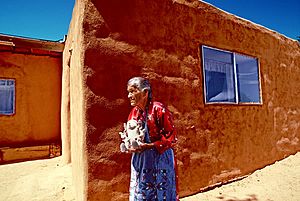Helen Cordero facts for kids
Quick facts for kids
Helen Cordero
|
|
|---|---|

Cordero in 1986
|
|
| Born |
Helen Quintano
June 15, 1915 |
| Died | July 24, 1994 (aged 79) |
| Occupation | Traditional potter |
| Known for | Storyteller pottery figurines |
| Spouse(s) | George Cordero |
| Children | 5 |
| Awards | Santa Fe Living Treasure, 1985; National Heritage Fellow, 1986 |
Helen Cordero (born June 15, 1915 – died July 24, 1994) was a famous artist from the Cochiti Pueblo in New Mexico. She was known for creating special clay figures called storyteller pottery figurines. These unique figures were her own idea, inspired by older traditions.
Contents
Becoming an Artist
Helen Cordero first learned to make things from leather. In the 1950s, she started working with clay. She made pottery birds and animals, and her husband would paint them.
It's said that Helen's aunt suggested she use clay. Clay was cheaper than leather. Her aunt also told her to try making figures. Helen's first tries at bowls and jars didn't turn out well.
Helen's Art Style
Helen Cordero followed a traditional way of making pottery. She would dig her own clay from near Cochiti Pueblo. She also prepared her own paints from clay and plants.
Over time, Helen's artwork became more detailed. She started making the small children figures separately. This allowed her to place them in different spots around the main storyteller figure. Helen also developed a special face that her dolls are now famous for.
Helen felt a deep connection to her art. She once said, "They're my little people. I talk to them and they're singing." This shows the Pueblo belief that clay is alive. It means the figures are like living beings.
The Storyteller Figures
Cochiti women potters traditionally made figures of women with children. These were called "Singing Mother" figures. In 1964, Helen Cordero changed this idea into her famous Storyteller design.
One story says that a designer named Alexander Girard asked her to create the first Storyteller. However, Helen herself said in 1981 that she created the first one on her own in 1964. She explained, "I made some more of my Storytellers with lots of children climbing on him to listen." She then took them to a feast day, where Alexander Girard bought them.
Alexander Girard bought many of Helen's early works. He asked her to make more figures and larger ones. This led to her creating a big Nativity set with 250 pieces. It's also thought that Girard suggested Helen make a larger "Singing Mother" figure.
Helen thought about this idea and remembered her grandfather, Santiago Quintana. He was a wonderful storyteller. Her grandfather inspired her first Storyteller figure. It was a male figure surrounded by five grandchildren. After 1964, other family members joined her in making these popular figures.
Helen described how she worked:
- She worked outdoors when the weather was warm.
- In winter, she worked at her kitchen table.
- Her husband and son would drive far to get the cedar wood she used.
- She used this wood to fire her clay pieces.
- She fired them on an open iron grate behind her house.
Helen's Storyteller design became very popular. Other potters started making their own versions. Some even made animal storytellers. By the 1990s, more than 200 potters were making Storyteller figures. To make her work stand out, Helen started signing her pieces. After the success of the Storyteller, Helen also created other types of figures. These included drummers, singing mothers, Pueblo fathers, and Hopi maidens.
Helen's Life
Helen Cordero lived her whole life in Cochiti Pueblo. She married Fred Cordero, who was an artist, drum-maker, and even a governor of Cochiti Pueblo. They had four children together.
Where to See Her Art
You can find Helen Cordero's artwork in many museums. Some of these include:
- The Museum of International Folk Art in Santa Fe, New Mexico.
- The New Mexico Museum of Art in Santa Fe, New Mexico.
- The Museum of Texas Tech University in Lubbock, Texas.
- The Smithsonian American Art Museum in Washington, DC.
- The Heard Museum in Phoenix.
- The Bandelier National Monument museum in Los Alamos Co., New Mexico.
- The Brooklyn Museum.
Awards and Honors
Helen Cordero received several important awards for her work:
- In 1985, she was honored as a Santa Fe Living Treasure.
- In 1986, she received a National Heritage Fellowship. This is the highest honor the United States government gives for folk and traditional arts.
- The Helen Cordero Primary School in Albuquerque, New Mexico, is named after her.

